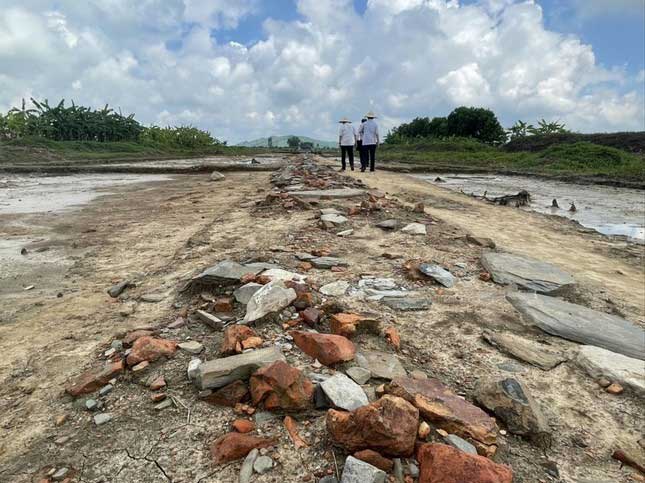Scientists have recently announced that along the Royal Road of the Hồ Dynasty heritage, many significant architectural remnants of the ancient capital have been uncovered.
The Vietnam Institute of Archaeology, in collaboration with the Department of Culture, Sports and Tourism of Thanh Hóa, and the Center for the Preservation of the Hồ Dynasty Heritage, organized a workshop to report preliminary findings from the excavation of the Royal Road within the World Heritage site of the Hồ Dynasty.

Many significant architectural remnants of the ancient capital were revealed during the excavation at the Hồ Dynasty.
The Royal Road (or Imperial Path) is the road that the emperor traveled, located in the center of the capital along the North-South axis in the overall planning of ancient Eastern capitals. Archaeologists have clarified the stratigraphy from the modern road to the remnants of the foundation and pavement of the Hồ Dynasty road, consisting of three main layers corresponding to three phases of the road. The top layer is the current National Highway 217, which runs through the central axis of the Hồ Dynasty citadel.
The second layer (the middle layer) consists of remnants of the road built during the French colonial period in 1937. The third layer is the reinforced foundation of the Royal Road. However, in the excavation pits in area B, the road was destroyed during the earthworks for road construction in 1937, leaving only the reinforced foundation layer of the Hồ Dynasty Royal Road, which is a mixture of yellow clay and red clay that creates a flat surface for the road and courtyard between the structures.
Along the Royal Road, scientists have discovered many significant architectural remnants of the ancient capital. On the Royal Road in areas A and B, dozens of large architectural remnants of the capital have been revealed. In area A, structures were uncovered in 2020 and 2021, with a central architectural complex located at the King’s Platform.
In area B, from late 2021 to July 2022, two gate structures and a central architectural complex were revealed in an area with two stone terraces carved with dragons from the Trần and Hồ periods. Notably, the remnants of the Dragon Complex are considered important due to their significant size and strategic location, close to a stone terrace with dragon carvings from the Trần and Hồ periods, which is predicted to be the site where the main hall of the Hồ Dynasty citadel may be found.
Archaeologists found various types of decorative bricks featuring chrysanthemum, lotus, and coin flower designs from the Lý and Trần dynasties, as well as floral patterns from the Lê dynasty, produced in Thăng Long. They also discovered square and rectangular bricks, as well as decorative bricks with Chinese characters produced at the Hồ Dynasty citadel, similar to findings from previous excavations. Additionally, scientists uncovered pieces of decorative lotus leaves, double lotus tiles, and curved tiles glazed in gold from the Trần and Hồ periods.
Associate Professor Dr. Tống Trung Tín, President of the Vietnam Archaeological Society, affirmed: “The initial excavation has clarified the current state of the structure and building materials of the Royal Road within the Hồ Dynasty heritage site. More importantly, it is necessary to study the Royal Road to understand the overall structure of the capital. In this regard, the excavation has yielded many new findings that contribute to understanding the structure and architecture of the Hồ Dynasty through various historical periods.”
| From November 2021 to July 2022, the Institute of Archaeology and the Center for the Preservation of the Hồ Dynasty Heritage excavated the Royal Road over a total area of 14,000 square meters, focusing on the central area of the inner city, divided into two sections: the area of excavation pits in the northern section of the East-West road with a total area of 3,500 square meters and the area of excavation pits in the southern section along the East-West road with a total area of 9,500 square meters. |





















































